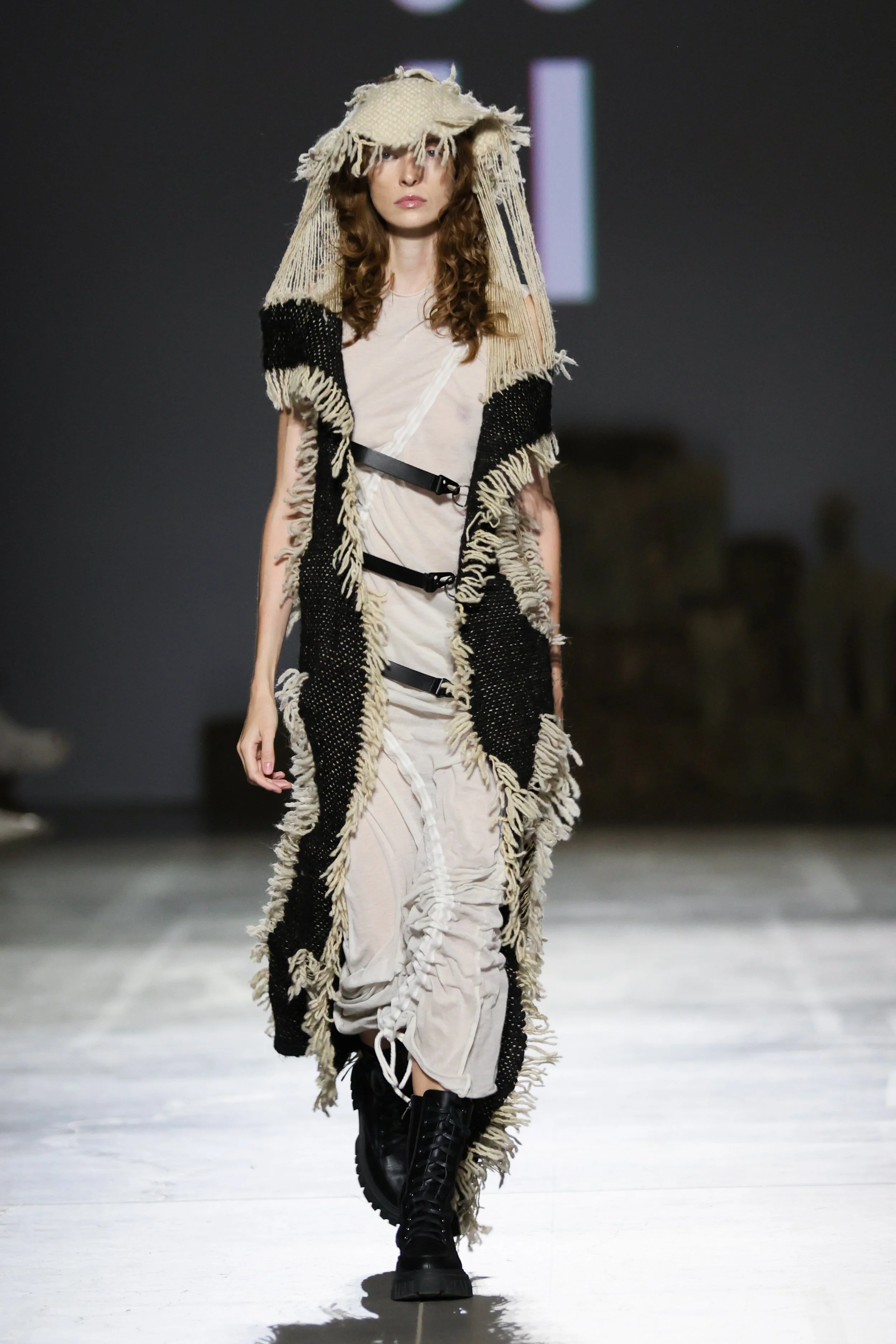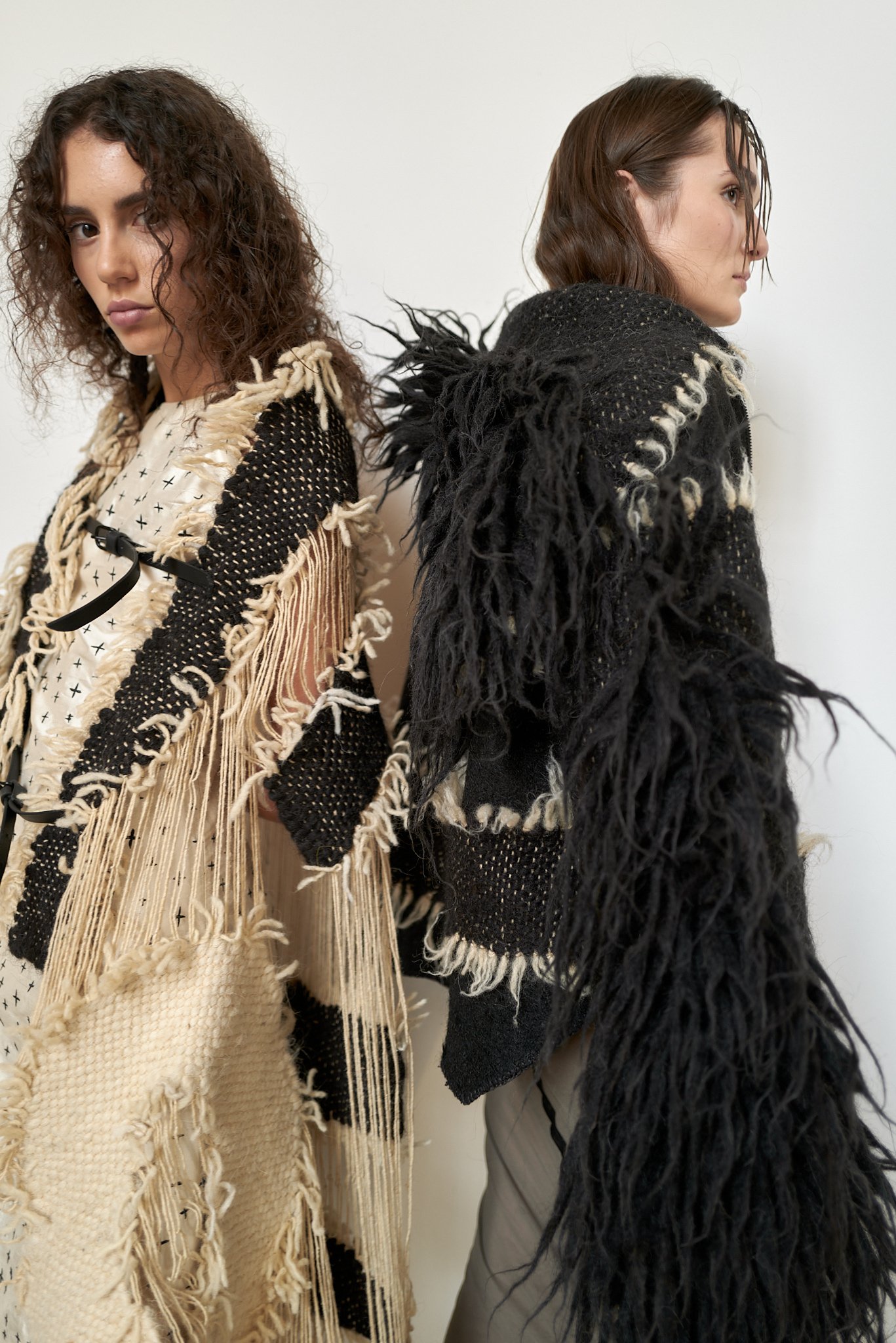Talent Talks: Mariia Pavlyk
Mariia Pavlyk's collections draw inspiration from Ukrainian pre-ancestral civilization, reflecting a harmonious way of life that values sustainability and tradition. Her work embodies responsibility and a deep respect for material origins, allowing her to reconcile her experiences shaped by the war in Ukraine and highlighting fashion's role as a form of resilience.
Photo by James Rees
Could you please introduce yourself?
My name is Mariia Pavlyk, and I’m a Ukrainian fashion designer based in Kyiv. Fashion has always been a powerful tool of self-expression for me, even though my journey in the industry began on the management side. I've had the privilege of working with emerging Ukrainian designers like Ediie Karimova and Kofta, where I gained valuable insights into the creative process and the fashion business.
Photo by Anya Wayne
My passion for the arts extended beyond fashion when I transitioned to managing an art residency in Kyiv and promoting Ukrainian artists internationally. This experience inspired me to start designing for myself, leading me to embrace slow fashion principles and a personal goal of creating most of my own wardrobe. In 2019, I launched a brand called ii, initially as a self-taught designer. However, the challenges brought by the COVID-19 pandemic and my desire to deepen my technical skills motivated me to pursue formal education. I was accepted into the Graduate Diploma course at the London College of Fashion, which eventually led to my graduation from the MA Fashion Design and Technology programme in February 2024.
Photo by James Rees
Having graduated recently, how do you look back on your studies?
Looking back on my academic experience, it was a pivotal moment in shaping my identity as a fashion designer committed to sustainability, storytelling, and craftsmanship. It taught me that a collection isn't just about creating clothes; it's about crafting wearable artefacts that carry stories, preserve culture, and hold deep meaning. I am profoundly grateful to the teaching team who guided me in transforming my ideas into designs that resonate on a deeper level. Despite the challenges of facing the war in Ukraine, which disrupted my GradDip course, my studies became a source of strength. They helped me channel my emotions and loss into creativity, turning fashion into a form of resilience. This experience allowed me to rediscover my purpose as a designer, merging my passion for art with a focus on creating meaningful, sustainable fashion.
Photo by Andriy Sokolov
Could you please tell us something about your graduation collection/project?
My graduation collection, "Spero," is my creative response to rediscovering my Ukrainian roots and heritage. Through my design process, I explore the concept of identity and the idea of wholeness, reconciling the parts of myself torn apart by the war in Ukraine. My work seeks to seamlessly blend traditional Ukrainian crafts with contemporary fashion design, emphasising the importance of preserving cultural heritage and artisanal skills.
On the 21st of July, 2023, I wrote in my diary “I tried to capture the delicate threads of history that stretch from distant ancestors to me, weaving them into a fabric capable of healing the wound that has gaped in my heart since the first days of the war."
Photo by Yulia Dahl
The primary inspiration for 'Spero' comes from the Tripillia-Cucuteni ornaments and traditional Hutsul weaving techniques. I returned to Ukraine in August 2023 for my research, marking my first visit since the beginning of the Russian invasion. I explored museums, visited flea markets, and spoke with archaeologists to uncover the roots of Ukrainian culture in the ancient Trypillia-Cucuteni civilisation. Their symbolic, language-like ornaments became the foundation for my pattern-making and design elements.
Photo by Anya Wayne
The collection consists of two main directions: narrative-driven pattern cutting and traditional Ukrainian weaving. During my time in the Carpathian Mountains, I had the privilege to learn weaving techniques directly from local artisans. Using Trypillia-inspired motifs as a base, I integrated these patterns into the woven pieces, reimagining the weaving process to create something new and innovative.
For me, weaving is a form of meditation. The process itself and its connection with nature temporarily distract me from the emotional trauma of losing a sense of home. Weaving symbolises the pursuit of wholeness while allowing for the creation of something new. It embodies the idea of being reborn and fuels my hope for a brighter future for my country.
Photo by James Rees
Which materials, techniques, programmes and/or applications are you mostly interested in?
In my collection, I focus on using sustainable materials and experimental cutting techniques to minimise textile waste. I draw inspiration from traditional Hutsul weaving techniques, with pieces handcrafted in the Carpathians using local hand-spun wool. For items incorporating experimental cutting, I source fabrics from certified eco-friendly producers and select Italian deadstock.
My pattern-cutting approach aims to achieve zero waste while still creating complex and inspiring designs. I noticed that many zero-waste methods rely on simple geometrical shapes, often resulting in minimalistic or draped styles. I believe there's room to push these boundaries and introduce more innovative ways to achieve zero waste without compromising creativity or complexity.
Photo by James Rees
While I'm deeply passionate about zero-waste techniques, I also have a strong connection to textile arts like embroidery, felting, cyanotype, screen printing, knitting, and weaving. These techniques allow me to add layers of meaning to my work, creating pieces that are not just garments but also stories that can be easily read by observers.
For me, the blend of reducing waste through innovative cutting and expressing narratives through textile work is key to creating fashion that truly resonates.
Photo by Andriy Sokolov
The exhibition you are a part of looks into the meaning of regeneration. What does regeneration mean to you and your work?
Regeneration is a fundamental concept in my work, representing both a creative and an emotional process. It signifies the ability to transform and renew—whether it's reimagining traditional techniques, revitalising forgotten crafts, or breathing new life into sustainable practices.
For me, regeneration is a complex idea that impacts how and what deserves to appear on our planet. As designers, we bear responsibility for the substantial textile waste generated worldwide. I see regeneration as a spiral movement, emphasising the need to look back at our roots before moving forward. It embodies slow, circular, and sustainable fashion that transforms clothing into something more meaningful.
In my work, regeneration represents the revival of traditions and support for local productions, materials, and crafts. The artefacts I create are designed to tell a story, empowering the wearer and fostering an emotional connection.
Photo by Andriy Sokolov
How do you perceive the meaning and importance of community within the fashion field?
Community in fashion is an essential force that fosters connection, communication, education, and change. Together, we have the potential to drive meaningful transformations and advocate for positive progress in the industry. I've seen the importance of community in my own country, where ordinary people come together to find quicker solutions for those in need than institutions can provide. By collaborating with designers and organisations that prioritise sustainable values, we can achieve greater impact and make a real difference.
The concept of community in fashion, for me, also includes the artisans and workers involved in the production process, who deserve to have their voices heard. Initiatives like "garment passports" demonstrate a step toward transparency, showcasing the origins of materials and acknowledging the individuals behind the creation of each garment. This accountability is crucial for the sustainability shift we must all embrace. By nurturing a strong sense of community, we can build a fashion industry that is more equitable, responsible, and inclusive for everyone involved.
Photo by James Rees
How do you view the future of fashion? And your own role therein?
The future of fashion is undeniably intertwined with technology, especially as we enter an era powered by AI. While I find this evolution exciting, it also brings a sense of concern. AI can be a valuable tool for innovation, but it also poses risks that we need to address carefully. I believe that comprehensive legislation is crucial in this field to facilitate positive change and tackle sustainability issues.
Photo by James Rees
In my own practice, I see AI as a potential ally, particularly in addressing complex zero-waste pattern challenges. Additionally, I believe that 3D designs will play a significant role in the metaverse, and I aspire to contribute to this by infusing a sense of tangible craft into future digital experiences. My goal is to bridge the gap between traditional craftsmanship and innovative technology, ensuring that the essence of fashion remains rooted in artistry and meaningful narratives, even as we explore new dimensions in the digital realm.
In my practice, I view AI as a valuable partner, especially when tackling intricate zero-waste pattern challenges. I also believe that 3D designs will be pivotal in the metaverse, and I aim to incorporate a sense of tangible craftsmanship into future digital experiences. My goal is to connect traditional artistry with innovative technology, ensuring that the essence of fashion remains grounded in creativity and meaningful stories, even as we venture into new digital landscapes.
Photo by Yulia Dahl












